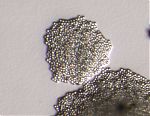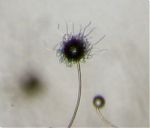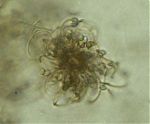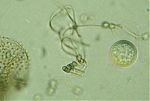Benjaminiella
BENJAMINIELLA v. Arx, 1981 (_The Genera of Fungi Sporulating in Pure Culture_, 3rd Ed., p. 60); 3 spp. (Benjamin, 1960—ILLUS. as Cokeromyces poitrasii; Benny and Benjamin, 1976—ILLUS. as Mycotypha poitrasii; Brain and Young, 1979—illus. as M. poitrasii; Cole and Samson, 1979—illus. as M. poitrasii; Benny et al., 1985—ILLUS. and key to spp.; Kirk, 1989—ILLUS. and KEY TO SPP.).
= Benjaminia Pidoplichko & Mil’ko, 1971 ( Atlas of Mucoralean Fungi, p. 96).
Species of Benjaminiella produce sporangiola on relatively long, curved to twisted and contorted, unbranched pedicels that are formed over the entire surface of the fertile vesicle. The fertile vesicles are formed on the apex of the sporangiophore or its branches. The pedicels and sporangiola are released as a unit when dehiscence occurs at a circimscissile zone formed at the pedicel base; this leaves denticles regularly scattered on the surface of the vesicles. These fungi are homothallic and the zygosporangial wall is pigmented and ornamented, and the zygospore wall is hyaline (Benny et al., 1985; Kirk, 1989).
Type species: B. poitrasii
Species of Benjaminiella:
B. multispora Benny, Samson & Srinivasan, 1985 (in Benny, Kirk, and Samson, Mycotaxon 22:125).
B. poitrasii (R.K. Benjamin) von Arx, 1981 ( The genera of fungi sporulating in pure culture, 3rd ed., p. 60).
B. youngii P.M. Kirk, 1989 (Mycotaxon 35:122)
Eriksson and Hawksworth (1986) believe that Benjaminiella v. Arx and Benjaminella I. Tavares are homonyms but Kirk et al. (2001) do not support this idea. The type species, B. poitrasii, was originally described as a species of Cokeromyces and later it was transferred to Mycotypha (Benjamin, 1960; Benny and Benjamin, 1976). Benjaminiella was included in Cunninghamellaceae by Mil’ko and Beljakova (1967, 1970), and Mil’ko (1974). These fungi have been isolated from dung and soil (Benny and Benjamin, 1976; Benny et al., 1985; Kirk, 1989).
Benjaminiella species all form yeast cells on nutrient rich media. There is a transition from yeast cells, “intermediate,” and finally the hyphal form. Mannose was four times higher in the cell walls of the yeast phase than in the hyphal phase, with the “intermediate” phase walls having a mannose concentration between of the former two phases. Hexosamine and protein, were in the highest concentration whereas fatty acids were in the lowest concentration in the cell walls of the hyphal phase (Cole et al., 1980). Chitnis et al. (2002) detected eight chitin synthase genes in B. poitrasii; two genes were thought to be specific to the hyphal phase. Nuclear division is synchronous in Benjaminiella multispora and B. poitrasii but asynchronous in the species of Mycotypha examined (Forst and Prillinger, 1988).
Bibliography
Benjamin, R.K. 1960. Two new members of the Mucorales. Aliso 4:523-530.
Benny, G.L., and R.K. Benjamin. 1976. Observations on Thamnidiaceae (Mucorales). II. Chaetocladium, Cokeromyces, Mycotypha, and Phascolomyces. Aliso 8:391-424.
Benny, G.L., P. M. Kirk, and R. A. Samson. 1985. Observations on Thamnidiaceae (Mucorales). III. Mycotyphaceae fam. nov. and a re-evaluation of Mycotypha sensu Benny & Benjamin illustrated by two new species. Mycotaxon 22:119-148.
Brain, A.P.R., and T.W.K. Young. 1979. Ultrastructure of the asexual apparatus in Mycotypha. Microbios 25:93-106.
Chitnis, M.V., C.A. Munro, A.J.P. Brown, G.W. Gooday, N.A.R. Gow, and M.V. Deshpande. 2002. The zygomycetous fungus, Benjaminiella poitrasii contains a large family of differentially regulated chitin synthase genes. Fung. Genet. Biol. 36:215-223.
Cole, G.T., and R.A. Samson. 1979. Patterns of Development in Conidial Fungi. Pitman Publishing Limited, London. 190 p.
Cole, G.T., T. Sekiya, R. Kasai, and Y. Nozawa. 1980. Morphogenesis and wall chemistry of the yeast, “intermediate”, and hyphal phases of the dimorphic fungus, Mycotypha poitrasii. Can. J. Microbiol. 26:36-49.
Eriksson, O., and D. L. Hawksworth. 1986. 30. Benjaminella I. Tav., p. 122, In O. Eriksson and D. L. Hawksworth. Notes on ascomycete systematics. Nos. 1-224. Systema Ascomycetum 5:113-174.
Forst, T.G., and H. Prillinger. 1988. Vergleichende karyologische Untersuchengen an dimorphen Zygomyceten. Zeit. Mykol. 54:139-153.
Kirk, P.M. 1989. A new species of Benjaminiella (Mucorales: Mycotyphaceae). Mycotaxon 35:121-125.
Kirk, P.M., P.F. Cannon, J.C. David, and J.A. Stalpers (eds.). 2001. Ainsworth & Bisby’s Dictionary of the Fungi. 9th Ed. CAB International, Wallingford, United Kingdom. 655 p
Mil’ko, A.A. 1974. Opredeltiel’ mukoral’nykh gribov [ Key to the identification of Mucorales ]. ‘Naukova Dumka’ , Kiev, Ukraine. 303 p.
Mil’ko, A.A., and L.A. Beljakova. 1967. Rod Cunninghamella Matruchot I taxonomie Cunninghamellaceae [Genus Cunninghamella Matruchot and taxonomy of the Cunninghamellaceae]. Mikrobiologiya 36:684-690 [English translation available in Microbiology 36 (4):573-578, 1967]
Mil’ko, A.A., and L.A. Beljakova. 1970. The genus Choanephora Currey (Mucorales). Mikrobiologiya 38:894-902 [English translation available in Mikrobiologiya 38:864-770])
Updated Mar 14, 2005




